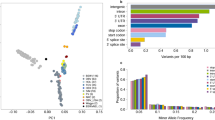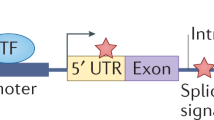Abstract
More than half of the reported missense changes in the breast cancer susceptibility protein BRCA1 occur in exon 11, but none has been clearly identified as disease associated and only 28 are designated ‘probable’ neutral polymorphisms. Previously, in a comparison of sequences from 57 eutherian mammal species, we found seven ‘highly conserved regions’ between amino acids 282 and 1103, and identified 38 missense changes as likely to disrupt gene function. These conserved regions were also present in birds and amphibians and included only six of the mutations predicted to affect function. In this new analysis, we hypothesized that using 37 ancestral sequences derived from the 57 GenBank sequences and including eight marsupial sequences would allow us to identify regions unique to mammals and refine our predictions of disease-associated missense changes. We identified 13 conserved regions, three of which appear to be unique to mammals, and 21 likely disease-associated missense changes, 11 of which occur in conserved regions. Seven regions identified in this analysis, including the three found only in mammalian sequences, and nine missense changes predicted to affect function are in the putative STAT1-interaction domain, suggesting that the role of STAT1 in immune response is important to mammary function. The reduction in the number of missense changes predicted to be disease associated and the identification of conserved regions specific to mammals can facilitate the further study of the role of missense changes in BRCA1-associated breast cancers.
This is a preview of subscription content, access via your institution
Access options
Subscribe to this journal
Receive 50 print issues and online access
$259.00 per year
only $5.18 per issue
Buy this article
- Purchase on Springer Link
- Instant access to full article PDF
Prices may be subject to local taxes which are calculated during checkout



Similar content being viewed by others
References
Bell G, Karam J and Rutter W . (1981). Proc. Natl. Acad. Sci., 78, 5759–5763.
Brown JR, Douady CJ, Italia MJ, Marshall WE and Stanhope MJ . (2001). Nat. Genet., 28, 281–285.
Brzovic PS, Meza JE, King MC and Klevit RE . (2001). J. Biol. Chem., 276, 41399–41406.
Canfield PJ, Hartley WJ and Reddacliff GL . (1990a). J. Comp. Pathol., 103, 147–158.
Canfield PJ, Hartley WJ and Reddacliff GL . (1990b). J. Comp. Pathol., 103, 135–146.
Casey HW, Giles RC and Kwapien RP . (1979). Recent Results Cancer Res., 66, 129–160.
Castilla LH, Couch FJ, Erdos MR, Hoskins KF, Calzone K, Collins FS and Weber BL . (1994). Nat. Genet., 8, 387–391.
Chapman MA, Charchar FJ, Kinston S, Bird CP, Grafham D, Rogers J, Grutzner F, Marshall Graves JA, Green AR and Gottgens B . (2003). Genomics, 81, 249–259.
Chen CF, Li S, Chen Y, Chen PL, Sharp ZD and Lee WH . (1996). J. Biol. Chem., 271, 32863–32868.
Durocher F, Shattuck-Eidens D, McClure M, Labrie F, Skolnick MH, Goldgar DE and Simard J . (1996). Hum. Mol. Genet., 5, 835–842.
Fabbro M, Rodriguez JA, Baer R and Henderson BR . (2002). J. Biol. Chem., 277, 21315–21324.
Findlay L and Renfree M . (1984). Physiological Strategies in Lactation, Vol. 51. Peak M, Vernon RG, Knight CH (eds). Academic Press: London, pp. 403–432.
Fleming MA, Ostrander G, Ramirez CJ, Potter J and Ostrander EA . (2003). Proc. Natl. Acad. Sci., 100, 1151–1156.
Friedman LS, Ostermeyer EA, Szabo CI, Dowd P, Lynch ED, Rowell SE and King MC . (1994). Nat. Genet., 8, 399–404.
Ganesh S, Agarwala KL, Amano K, Suzuki T, Delgado-Escueta AV and Yamakawa K . (2001). Biochem. Biophys. Res. Commun., 283, 1046–1053.
Gonnet GH, Cohen MA and Benner SA . (1992). Science, 256, 1443–1445.
Hamilton JM . (1974). Adv. Cancer Res., 19, 1–45.
Huber LJ, Yang TW, Sarkisian CJ, Master SR, Deng CX and Chodosh LA . (2001). Mol. Cell. Biol., 21, 4005–4015.
Huelsenbeck J and Ronquist F . (2001). Bioinformatics, 17, 754–755.
Huttley GA, Easteal S, Southey MC, Tesoriero A, Giles GG, McCredie MR, Hopper JL and Venter DJ . (2000). Nat. Genet., 25, 410–413.
Jeanmougin F, Thompson JD, Gouy M, Higgins DG and Gibson TJ . (1998). Trends Biochem. Sci., 23, 403–405.
Knight CH . (1984). Physiological Strategies in Lactation, Vol. 51. Peak M, Vernon RG, Knight CH (eds). Academic Press: London, pp. 147–170.
Koeberl DD, Bottema CD, Ketterling RP, Bridge PJ, Lillicrap DP and Sommer SS . (1990). Am. J. Hum. Genet., 47, 202–217.
Kumar S and Hedges SB . (1998). Nature, 392, 917–920.
Lee WH and Boyer TG . (2001). Lancet, 358 (Suppl), S5.
Maddison D and Maddison W . (2001). MacClade 4: Analysis of phylogeny and character evolution. Sinauer Associates: Sunderland.
Malone KE, Daling JR, Neal C, Suter NM, O'Brien C, Cushing-Haugen K, Jonasdottir TJ, Thompson JD and Ostrander EA . (2000). Cancer, 88, 1393–1402.
Misdorp W . (1996). Vet. Q., 18, 32–36.
Monteiro AN, August A and Hanafusa H . (1996). Proc. Natl. Acad. Sci. USA, 93, 13595–13599.
Newman B, Mu H, Butler LM, Millikan RC, Moorman PG and King MC . (1998). JAMA, 279, 915–921.
Nielsen R and Yang Z . (1998). Genetics, 148, 929–936.
Ouchi T, Lee SW, Ouchi M, Aaronson SA and Horvath CM . (2000). Proc. Natl. Acad. Sci. USA, 97, 5208–5213.
Posada D and Crandall K . (1998). Bioinformatics, 14, 817–818.
Rose TM, Schultz ER, Henikoff JG, Pietrokovski S, McCallum CM and Henikoff S . (1998). Nucleic Acids Res., 26, 1628–1635.
Shen D and Vadgama JV . (1999). Oncol Res., 11, 63–69.
Siegel S . (1956). Nonparametric Statistics for the Behavioral Sciences. McGraw-Hill: New York.
Simard J, Tonin P, Durocher F, Morgan K, Rommens J, Gringras S, Samson C, Leblanc JF, Belanger C, Dion F, Liu Q, Skolnick M, Goldgar DE, Shattuck-Eidens D, Labrie F and Narod SA . (1994). Nat. Genet., 8, 392–398.
Sokal RR and Rohlf FJ . (1995). Biometry: The Principles Practice of Statistics in Biological Research, 3rd edn. WH Freeman Company: New York.
Stark GR, Kerr IM, Williams BR, Silverman RH and Schreiber RD . (1998). Annu. Rev. Biochem., 67, 227–264.
Straube EF and Callinan RB . (1980). J. Comp. Pathol., 90, 495–497.
Swofford D . (1998). PAUP*. Phylogenetic Analysis Using Parsimony (* and other Methods). Sinauer Associates: Sunderland.
Szabo C, Masiello A, Ryan JF and Brody LC . (2000). Hum. Mutat., 16, 123–131.
Tyndale-Biscoe CH, Stewart F and Hinds LA . (1984). Physiological Strategies in Lactation, Vol. 51. Peak M, Vernon RG, Knight CH (eds). Academic Press: London, pp. 389–401.
Vail DM and MacEwen EG . (2000). Cancer Invest., 18, 781–792.
Vallon-Christersson J, Cayanan C, Haraldsson K, Loman N, Bergthorsson JT, Brondum-Nielsen K, Gerdes AM, Moller P, Kristoffersson U, Olsson H, Borg A and Monteiro AN . (2001). Hum. Mol. Genet., 10, 353–360.
Venkitaraman AR . (2001). J. Cell Sci., 114, 3591–3598.
Welcsh PL and King MC . (2001). Hum. Mol. Genet., 10, 705–713.
Acknowledgements
We thank Dr John AW Kirsch of the University of Wisconsin Zoological Museum for the Virginia opossum tissue sample, Dr Tammie Bettinger of the Cleveland Zoo for red kangaroo and wallaroo blood samples, and Dr Janis Joslin of the Woodland Park Zoo for tree kangaroo blood samples. This work was supported by Grant T32-HG00035 to CJ Ramirez, Grant K05 CA-90754-01 to EA Ostrander, and Grant U24 CA-78164 to JD Potter.
Author information
Authors and Affiliations
Corresponding author
Rights and permissions
About this article
Cite this article
Ramirez, C., Fleming, M., Potter, J. et al. Marsupial BRCA1: conserved regions in mammals and the potential effect of missense changes. Oncogene 23, 1780–1788 (2004). https://doi.org/10.1038/sj.onc.1207292
Received:
Revised:
Accepted:
Published:
Issue Date:
DOI: https://doi.org/10.1038/sj.onc.1207292
Keywords
This article is cited by
-
DNA damage repair system in C57BL/6 J mice is evolutionarily stable
BMC Genomics (2021)
-
Design and Synthesis of BRCA1 (856-871) Analogous and their Interactions with RAD51 (158-180)
International Journal of Peptide Research and Therapeutics (2021)
-
Biomolecular Interactions of RAD51181–200 with BRCA1846–871 and Mutants and Molecular Docking Approach
International Journal of Peptide Research and Therapeutics (2020)
-
Molecular and clinical characterization of an in frame deletion of uncertain clinical significance in the BRCA2 gene
Breast Cancer Research and Treatment (2012)
-
Natural selection and mammalian BRCA1 sequences: elucidating functionally important sites relevant to breast cancer susceptibility in humans
Mammalian Genome (2006)



